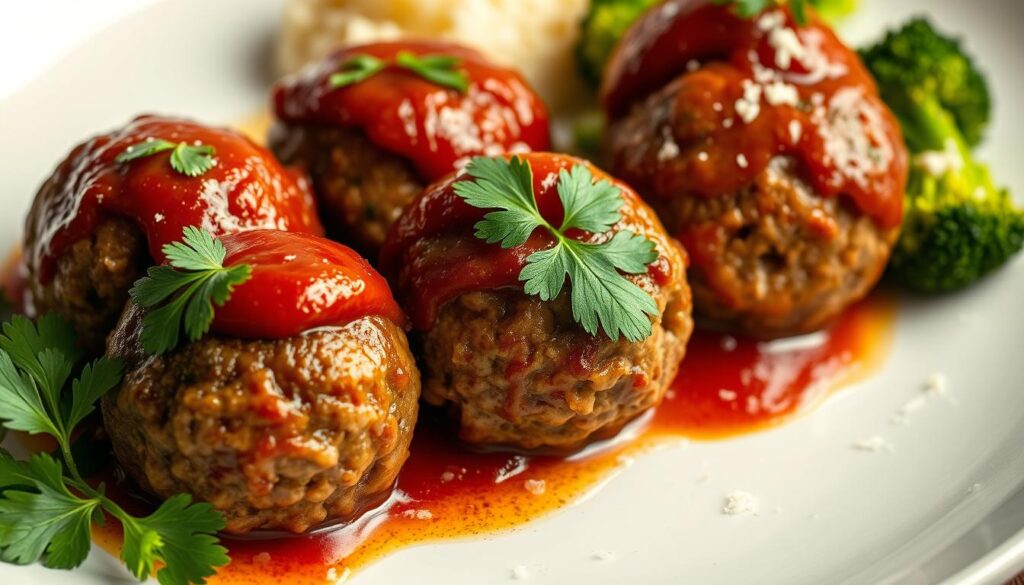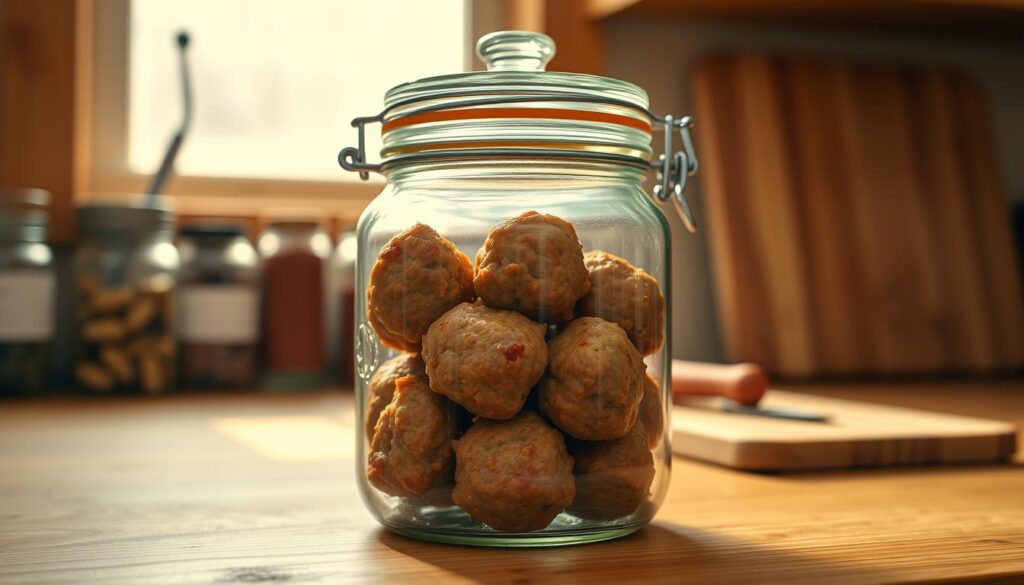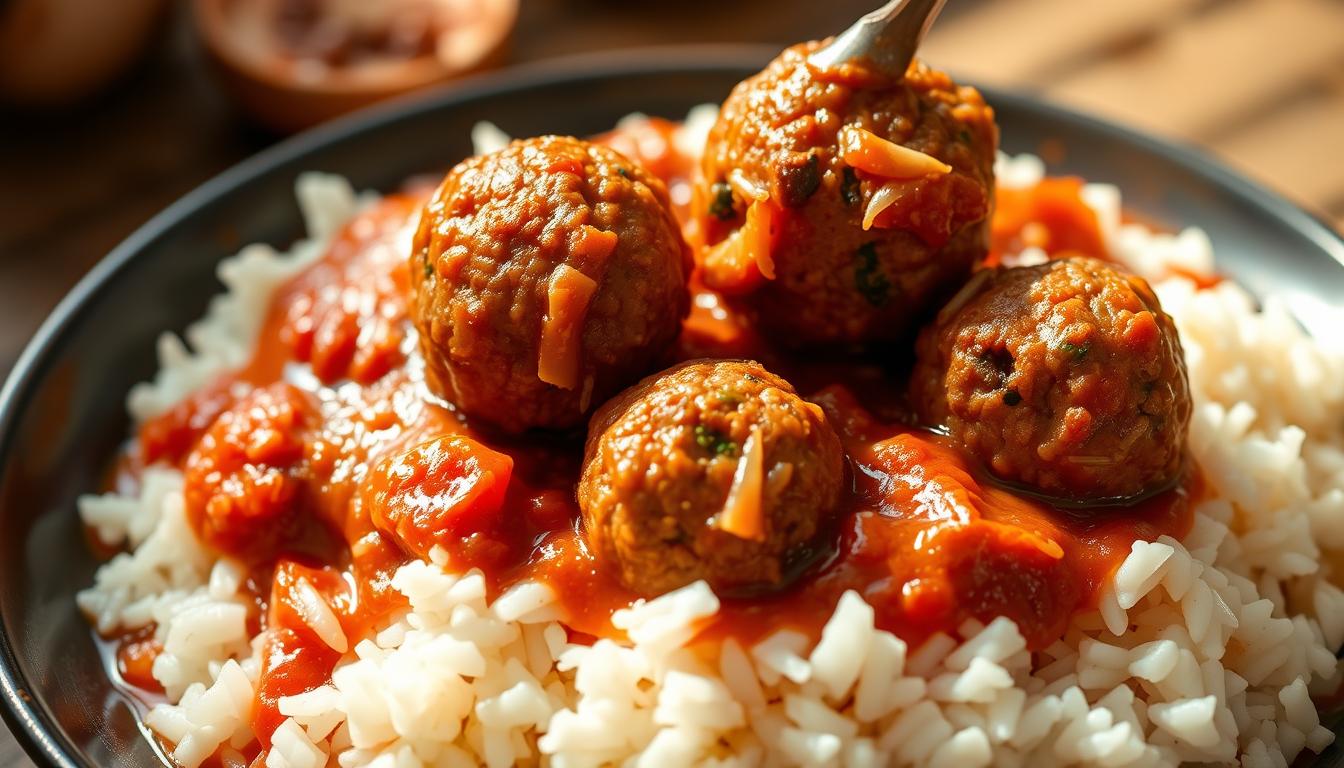Explore the world of Porcupine Meatballs, a beloved dish in American kitchens for years. It combines ground beef and rice in a recipe that turns simple ingredients into a cozy meal. This dish is a story of culinary creativity.
These meatballs started during the Great Depression. They show how cooks can make tasty meals with little. The rice on the outside makes them look like porcupines, adding to their charm and taste.
Key Takeaways
- Authentic American comfort food with historical roots
- Easy to prepare with budget-friendly ingredients
- Unique texture from rice-embedded ground beef
- Versatile dish suitable for family dinners
- Nutritious meal packed with protein and flavor
What Are Porcupine Meatballs?
Porcupine meatballs are a fun homemade dish. They mix ground beef with a unique twist. The uncooked rice poking out during cooking gives them a fun “porcupine-like” look.
These meatballs became popular during tough economic times, like after World War II. They were a smart way to make ground beef stretch further by adding rice to the mix.
Origins of the Recipe
The recipe started with home cooks wanting to make meals with less. Brands like Hunt’s helped make it famous with creative ads. These ads taught people how to cook it.
- Developed as an economical meal option
- Gained widespread popularity in mid-20th century
- Represents culinary creativity during resource-limited periods
Unique Ingredients and Preparation
What makes porcupine meatballs special is the uncooked white rice. When cooked, the rice expands and sticks out, giving them a porcupine-like look.
The recipe calls for 93% lean ground beef to reduce grease. Each meatball has about two tablespoons of the meat and rice mix. This makes about 24 meatballs per batch.
Ingredients for Porcupine Meatballs
Making these tasty porcupine meatballs is easy. You probably have all the ingredients in your kitchen. The dish is simple to prepare and full of flavor.
To start making perfect porcupine meatballs, you need the right ingredients. Here’s what you’ll need:
Essential Ingredients for Meatballs
- 1 pound lean ground beef (80/20 ratio recommended)
- ½ cup uncooked long-grain white rice
- ¼ cup finely diced onion
- 1 large egg
- 1 tablespoon Worcestershire sauce
- ½ teaspoon garlic powder
- ¼ teaspoon salt
- ¼ teaspoon black pepper
- 2 tablespoons fresh chopped parsley
Tomato Sauce Ingredients
- 8 ounces tomato sauce
- 10.75 ounces condensed tomato soup
- 1 cup vegetable juice
- ½ teaspoon garlic powder
- Additional seasonings to taste
This recipe lets you get creative. The rice makes the meatballs unique, giving them a special texture.
Optional Add-Ins for Extra Flavor
Want to make your tomato sauce and meatballs even better? Try these optional ingredients:
- Fresh herbs like basil or oregano
- Red pepper flakes for a spicy kick
- Grated Parmesan cheese
- Minced garlic for extra depth
This recipe is flexible. You can change ingredients to fit your taste while keeping the classic porcupine meatballs feel.
How to Prepare Porcupine Meatballs
Making porcupine meatballs is an art that makes this dish a family favorite. It requires careful attention and a few key steps for delicious results.
Start by gathering your ingredients for a cooking adventure that will please your family. The secret to great porcupine meatballs is in mixing and shaping the meat just right.
Mixing the Ingredients
To make the perfect meatball mix, follow these steps:
- Use 80/20 ground beef for the best flavor and texture
- Add ⅔ cup of uncooked long-grain white rice
- Incorporate 2 tablespoons of grated onion
- Season with 1½ teaspoons of salt and ¼ teaspoon of black pepper
- Mix ingredients gently to avoid overworking the meat
The goal is to mix ingredients just until they’re combined. Overmixing can make the meatballs tough, which is not what we want in comfort food.
Shaping the Meatballs
Shaping porcupine meatballs needs a gentle touch. Here are some tips:
- Use about two tablespoons of mixture per meatball
- Make meatballs about 1½ inches in diameter
- Roll carefully, as the mixture can be delicate
- Make them all the same size for even cooking
Pro tip: Wet your hands slightly to prevent the mixture from sticking while shaping. This recipe makes about 16 meatballs that everyone will love!
Cooking Methods for Porcupine Meatballs
There are many ways to cook porcupine meatballs. Each method helps you make a tasty dish with the right texture and flavor. Knowing these methods ensures your meal is always a hit.
There are two main ways to cook porcupine meatballs: baking and stovetop simmering. Each method has its own benefits for your cooking.
Baking Your Porcupine Meatballs
Baking is a simple and easy way to cook porcupine meatballs. Here’s what you need to do:
- Preheat your oven to 350°F (175°C)
- Cover the baking dish for the first 45 minutes
- Uncover and bake for an additional 15 minutes
- Ensure internal temperature reaches 160°F
Stovetop Simmering Technique
If you like to cook hands-on, stovetop simmering is great:
- Cook meatballs in sauce over medium-low heat
- Simmer for 35-40 minutes
- Stir occasionally to prevent sticking
- Check internal temperature for doneness
“The key to perfect porcupine meatballs is maintaining moisture while ensuring the rice cooks thoroughly.”
Tips for Achieving Perfect Texture
To get the ideal texture for your porcupine meatballs, follow these tips:
- Use 80/20 ground beef for optimal moisture
- Keep meatballs approximately 1-1/2 inches in diameter
- Use uncooked long-grain rice
- Avoid overcrowding during cooking
No matter the method, your baked or simmered porcupine meatballs will impress everyone. They’re an easy recipe that always tastes great.
Serving Suggestions for Porcupine Meatballs
Porcupine meatballs are a classic comfort food that brings families together. These meat-and-rice spheres are versatile and pair well with many sides.
Transform your family favorite with the right presentation and sides. Here are some exciting ways to serve these tasty meatballs.
Perfect Sauce Pairings
The right sauce can make your porcupine meatballs even better. Try these tasty options:
- Classic tomato marinara sauce
- Creamy mushroom gravy
- Tangy BBQ sauce
- Zesty garlic herb sauce
Delicious Side Dishes
Pair your porcupine meatballs with these popular sides:
| Side Dish | Flavor Profile | Preparation Time |
|---|---|---|
| Creamy Mashed Potatoes | Rich and Smooth | 15 minutes |
| Steamed White Rice | Light and Neutral | 20 minutes |
| Roasted Green Beans | Crisp and Savory | 25 minutes |
| Caesar Salad | Tangy and Fresh | 10 minutes |
Arrange your meatballs on a platter, garnish with fresh herbs, and watch your family’s excitement grow. Pro tip: A sprinkle of parsley adds color and fresh flavor.
Nutritional Information
Explore the nutritional profile of these tasty homemade ground beef meatballs. They offer both flavor and health benefits. Knowing the nutritional content helps you make better dietary choices while enjoying a classic dish.
Caloric Content and Macronutrient Breakdown
A single serving of porcupine meatballs has a balanced nutritional profile. It fits into various diet plans. Here’s a detailed breakdown of what you can expect:
| Nutrient | Amount per Serving |
|---|---|
| Calories | 360 kcal |
| Total Fat | 15g |
| Protein | 36g |
| Carbohydrates | 20g |
| Fiber | 3g |
Health Benefits of Key Ingredients
The ingredients in these meatballs offer more than just great taste. Ground beef provides essential nutrients that support your health:
- Protein Power: With 36g per serving, these meatballs help muscle recovery and growth
- Mineral Rich: Contains iron and zinc from ground beef, supporting immune function
- Complex Carbohydrates: Rice adds fiber and sustained energy

By choosing lean ground beef and adding vegetables, you can make this dish even healthier. Enjoy your meatballs knowing they’re both delicious and nutritious!
Customizing Your Porcupine Meatballs
Making this classic dish your own is simple. Porcupine meatballs are a great base for creative changes. These can match your taste and dietary needs.
Trying new things lets you add your own touch. Yet, you keep the dish’s traditional charm.
Spicy Variations to Kick Up the Flavor
For those who enjoy a spicy kick, here are some ideas:
- Add 1-2 teaspoons of red pepper flakes to the meat mixture
- Mix in diced jalapeños for extra kick
- Use hot sauce in your tomato-based sauce
- Sprinkle cayenne pepper for subtle warmth
Vegetarian-Friendly Alternatives
It’s easy to make this dish vegetarian. Just swap ground beef with plant-based options. These should have similar texture and taste.
| Meat Substitute | Protein Content | Texture Match |
|---|---|---|
| Lentils | 18g per cup | Medium |
| Beyond Meat | 20g per serving | High |
| Impossible Meat | 19g per serving | Very High |
Remember, the fun is in trying new things. Your special version might become a family favorite!
Storing Leftover Porcupine Meatballs
Keeping your homemade porcupine meatballs fresh is easy. By storing them right, you can enjoy them for days after cooking.

After cooking, it’s key to keep your meatballs fresh and flavorful. Knowing how to store them can make them last longer and taste great.
Best Storage Practices
Here are the top tips for storing your meatballs:
- Cool meatballs completely before storing
- Use airtight containers to prevent moisture loss
- Refrigerate within 2 hours of cooking
- Store in the refrigerator for up to 4 days
Freezing Your Homemade Meatballs
Freezing is a great way to keep your meatballs for a long time.
| Storage Method | Duration | Recommended Approach |
|---|---|---|
| Refrigerator Storage | Up to 4 days | Store in sealed container |
| Freezer Storage | 3-4 months | Use freezer-safe containers |
Reheating Methods for Optimal Taste
Here’s how to make your meatballs taste like new:
- Microwave Method: Heat for 2 minutes, checking internal temperature
- Oven Reheating: Warm at 350°F for 10-15 minutes
- Stovetop Option: Gently reheat in a covered skillet with a splash of broth
Remember, always heat meatballs to 160°F for safety. With these tips, your porcupine meatballs will stay tasty and ready to eat!
Frequently Asked Questions
Porcupine meatballs are a beloved comfort food. They often raise questions among home cooks. This easy recipe answers some common queries to help you cook better and enjoy a tasty meal.
Can I Freeze Porcupine Meatballs?
Yes, you can freeze porcupine meatballs to save them for later. There are two ways to freeze them:
- Uncooked meatballs: Mix the ingredients, shape the meatballs, and freeze them on a baking sheet. Then, move them to a freezer-safe container once they’re frozen.
- Cooked meatballs: Cool the meatballs completely before freezing them in an airtight container.
Pro tip: Frozen porcupine meatballs can last up to 3 months. To eat them, thaw them in the fridge overnight and then reheat them well.
How Do I Make Them Gluten-Free?
Making a gluten-free version of this dish is easy. Here’s how to keep your recipe gluten-free:
- Choose a gluten-free Worcestershire sauce.
- Use gluten-free breadcrumbs or crushed gluten-free crackers.
- Make sure all spices and seasonings are gluten-free.
“With a few simple substitutions, anyone can enjoy this delicious dish, regardless of dietary restrictions.”
By following these tips, you can make this classic recipe gluten-free. It will taste great and keep its texture.
Conclusion: Enjoying Porcupine Meatballs at Home
Porcupine meatballs are a beloved dish in many American homes. They are easy to make and always bring happiness to dinner. Cooking them is a chance to make special memories with your family.
When you make these meatballs, you join a long-standing cooking tradition. You can try different meats and spices to make them your own. Whether you use beef or pork, you can make them special.
We encourage you to add your own twist to this recipe. Maybe you used a unique spice or changed ingredients for dietary reasons. Your creativity can inspire others and keep the dish fresh. Porcupine meatballs are a tasty way to connect with your family and tradition.
Now, you have a reliable recipe that you can customize. Enjoy the process of cooking and trying new things. And most importantly, savor every bite of your homemade porcupine meatballs.

